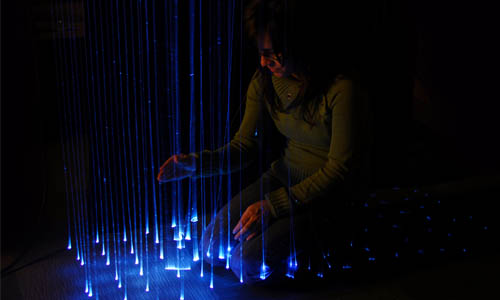Light Strings
Interactive Immersive Installation (2010)
Collaboration with Greg Corness
Concept
This project explores the relationship between the aesthetics of the interaction afforded by an immersive environment and its relation to the immersive experience of the user.
With this project we were interested in two main questions: how an experience with light may be made tactile, and how materiality and agency combine in an aesthetic of interaction for an installation. We have approached these questions in the immersive interactive installation Lightstrings, where the physical presence of media agents is rendered through a combination of tactile threads of light and the response of the agents to visitors in the environment. Side Glow Fiber Optics hung from the ceiling in long straight strands create an immersive space filled with fine threads of light. The fiber optics provides a tactile and visual sensation of immersion as they brush against the visitor’s face and body. Media agents are rendered through clusters of glowing strands perceived as moving beams of light. The sensation of touching the beams of light is expanded from just the tactile experience afforded by the fiber optics to one of agency since, through the use of motion tracking technology, the light beam responds to the visitor’s touch and presence. The quality of each visitorâ’s motion in the space affects the media agents behavior. A number of modes of aesthetic interaction with the media agents are being developed to encourage reflection, play and imagination as components of the quality of immersion.
Technical Description
Lightstrings is an immersive environment (15ft * 11ft * 12ft) filled with 2500 fiber optic lights. The system includes two computers for tracking the gestures of visitors and generating audio and video responses.
The environment uses Fiber Optics hung from the ceiling in long straight strands to create an immersive tactile space of fine threads of light. By bundling the fiber optic strands and projecting on to the ends, the glow from each thread can be controlled, allowing light patterns as well as individual patches to be manipulated in the space. The use of Side Glow Fiber Optics gives these patterns and patches of light are given a three-dimensional quality since the entire strand is able to glow along its length. The tactile experience is enhanced by enabling the quality of visitor’s motion to affect the media agents behavior. The visitor’s motion is tracked using an IR camera. The video image is analyzed using patches written in Max/Jitter. Signal processing and synthesis techniques implemented in Max/MSP are used to generate the sounds heard in the installation. Live recordings of the visitors in the space and small sounds caused by touching the fiber optics provide the source material for the soundscape.
Progress
Prototype 1.0
Acknowledgment
SIAT (School of Interactive Arts and Techology) at Simon Fraser University
ITST















 Â
 
